Property Economics and Finance Report: Financial and Taxation Analysis
VerifiedAdded on 2021/04/24
|26
|6909
|29
Report
AI Summary
This report provides a comprehensive analysis of the financial and taxation environments in Australia, with a specific focus on the Western Sydney Airport project. It examines the economic landscape, including the nation's strong economic performance and diversified economy, and details the various taxation schemes in place, such as income taxes, GST, and capital gains tax. The report identifies key tax incentives relevant to the project, like research and development incentives and early-stage innovation company incentives, and analyzes the implications of these incentives on investment decisions. Furthermore, it identifies and assesses various risk factors associated with the project, including market risk, liquidity risk, operational risk, and credit risk, providing insights into how these risks might impact investment decisions. The analysis provides a framework for understanding and addressing financial and taxation risks, offering valuable insights for financiers considering investments in the Western Sydney Airport project.
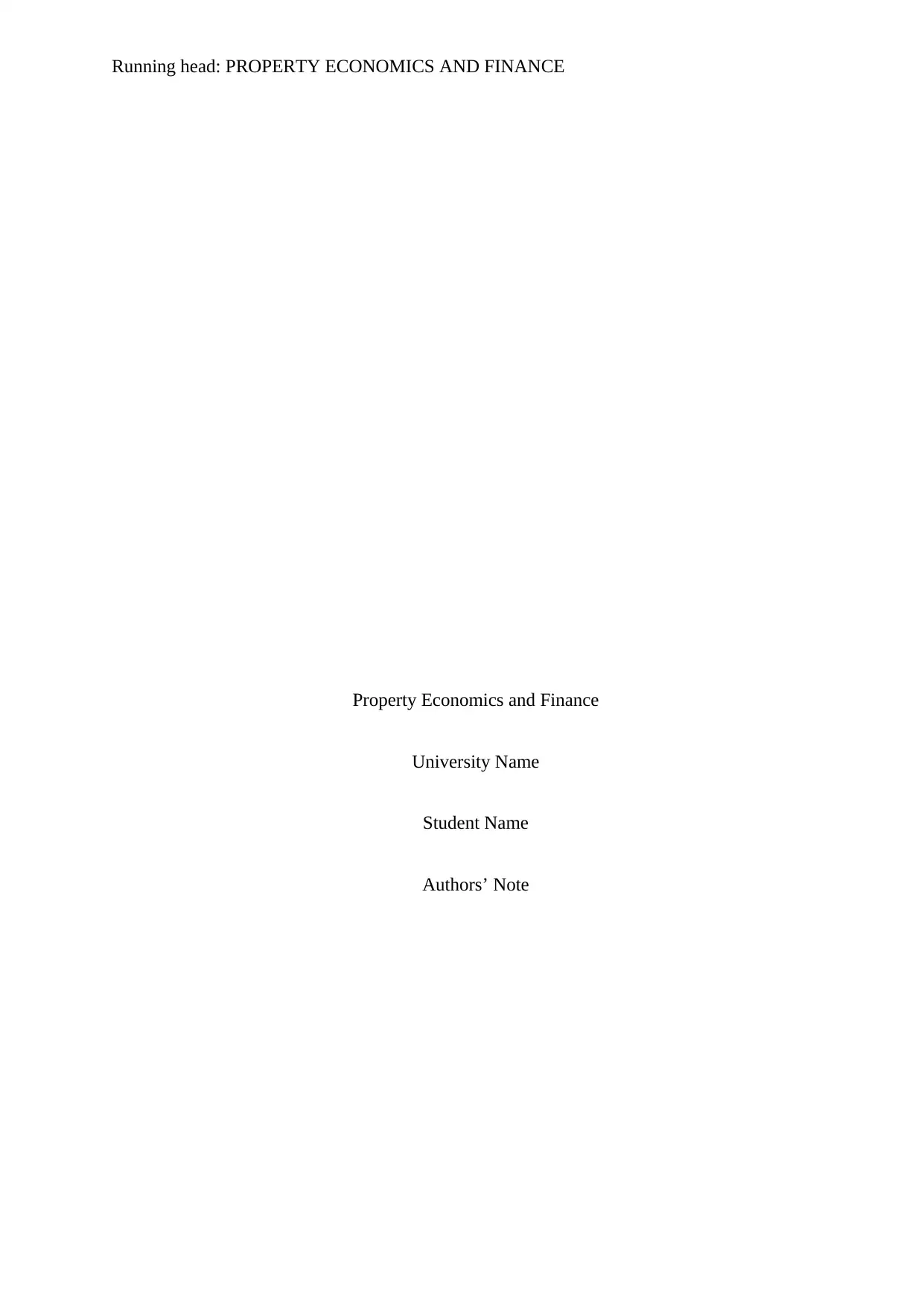
Running head: PROPERTY ECONOMICS AND FINANCE
Property Economics and Finance
University Name
Student Name
Authors’ Note
Property Economics and Finance
University Name
Student Name
Authors’ Note
Paraphrase This Document
Need a fresh take? Get an instant paraphrase of this document with our AI Paraphraser
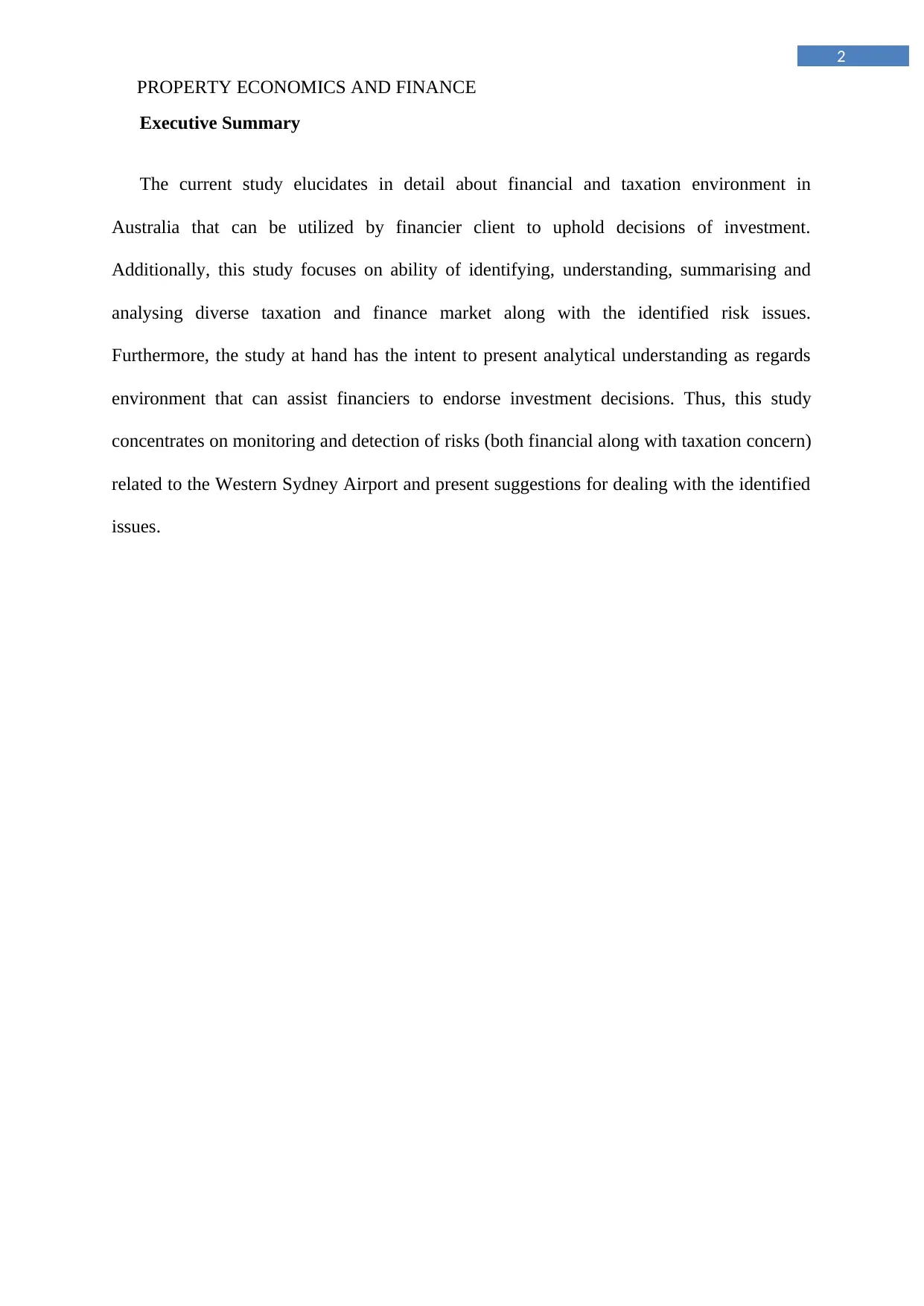
2
PROPERTY ECONOMICS AND FINANCE
Executive Summary
The current study elucidates in detail about financial and taxation environment in
Australia that can be utilized by financier client to uphold decisions of investment.
Additionally, this study focuses on ability of identifying, understanding, summarising and
analysing diverse taxation and finance market along with the identified risk issues.
Furthermore, the study at hand has the intent to present analytical understanding as regards
environment that can assist financiers to endorse investment decisions. Thus, this study
concentrates on monitoring and detection of risks (both financial along with taxation concern)
related to the Western Sydney Airport and present suggestions for dealing with the identified
issues.
PROPERTY ECONOMICS AND FINANCE
Executive Summary
The current study elucidates in detail about financial and taxation environment in
Australia that can be utilized by financier client to uphold decisions of investment.
Additionally, this study focuses on ability of identifying, understanding, summarising and
analysing diverse taxation and finance market along with the identified risk issues.
Furthermore, the study at hand has the intent to present analytical understanding as regards
environment that can assist financiers to endorse investment decisions. Thus, this study
concentrates on monitoring and detection of risks (both financial along with taxation concern)
related to the Western Sydney Airport and present suggestions for dealing with the identified
issues.
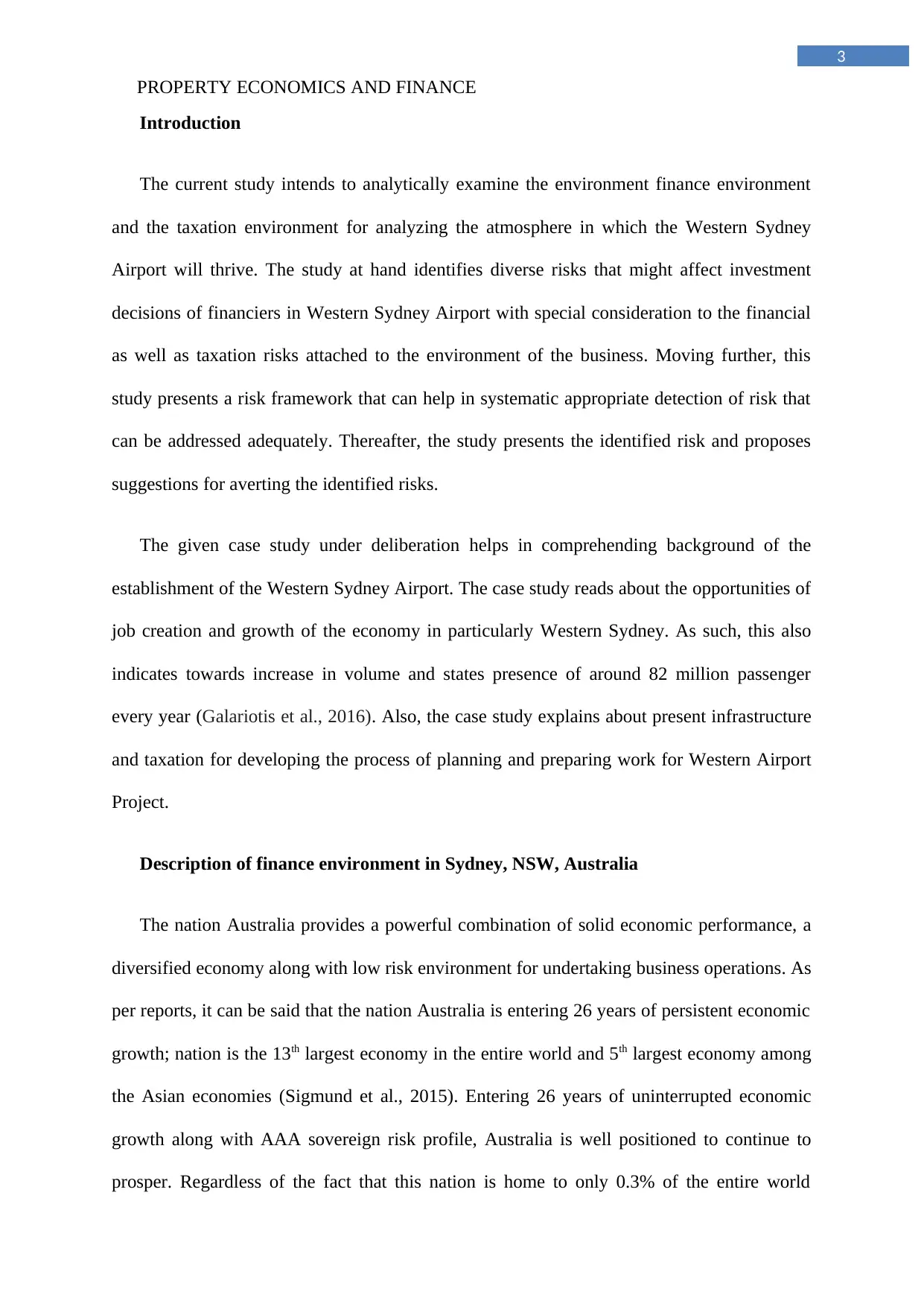
3
PROPERTY ECONOMICS AND FINANCE
Introduction
The current study intends to analytically examine the environment finance environment
and the taxation environment for analyzing the atmosphere in which the Western Sydney
Airport will thrive. The study at hand identifies diverse risks that might affect investment
decisions of financiers in Western Sydney Airport with special consideration to the financial
as well as taxation risks attached to the environment of the business. Moving further, this
study presents a risk framework that can help in systematic appropriate detection of risk that
can be addressed adequately. Thereafter, the study presents the identified risk and proposes
suggestions for averting the identified risks.
The given case study under deliberation helps in comprehending background of the
establishment of the Western Sydney Airport. The case study reads about the opportunities of
job creation and growth of the economy in particularly Western Sydney. As such, this also
indicates towards increase in volume and states presence of around 82 million passenger
every year (Galariotis et al., 2016). Also, the case study explains about present infrastructure
and taxation for developing the process of planning and preparing work for Western Airport
Project.
Description of finance environment in Sydney, NSW, Australia
The nation Australia provides a powerful combination of solid economic performance, a
diversified economy along with low risk environment for undertaking business operations. As
per reports, it can be said that the nation Australia is entering 26 years of persistent economic
growth; nation is the 13th largest economy in the entire world and 5th largest economy among
the Asian economies (Sigmund et al., 2015). Entering 26 years of uninterrupted economic
growth along with AAA sovereign risk profile, Australia is well positioned to continue to
prosper. Regardless of the fact that this nation is home to only 0.3% of the entire world
PROPERTY ECONOMICS AND FINANCE
Introduction
The current study intends to analytically examine the environment finance environment
and the taxation environment for analyzing the atmosphere in which the Western Sydney
Airport will thrive. The study at hand identifies diverse risks that might affect investment
decisions of financiers in Western Sydney Airport with special consideration to the financial
as well as taxation risks attached to the environment of the business. Moving further, this
study presents a risk framework that can help in systematic appropriate detection of risk that
can be addressed adequately. Thereafter, the study presents the identified risk and proposes
suggestions for averting the identified risks.
The given case study under deliberation helps in comprehending background of the
establishment of the Western Sydney Airport. The case study reads about the opportunities of
job creation and growth of the economy in particularly Western Sydney. As such, this also
indicates towards increase in volume and states presence of around 82 million passenger
every year (Galariotis et al., 2016). Also, the case study explains about present infrastructure
and taxation for developing the process of planning and preparing work for Western Airport
Project.
Description of finance environment in Sydney, NSW, Australia
The nation Australia provides a powerful combination of solid economic performance, a
diversified economy along with low risk environment for undertaking business operations. As
per reports, it can be said that the nation Australia is entering 26 years of persistent economic
growth; nation is the 13th largest economy in the entire world and 5th largest economy among
the Asian economies (Sigmund et al., 2015). Entering 26 years of uninterrupted economic
growth along with AAA sovereign risk profile, Australia is well positioned to continue to
prosper. Regardless of the fact that this nation is home to only 0.3% of the entire world
⊘ This is a preview!⊘
Do you want full access?
Subscribe today to unlock all pages.

Trusted by 1+ million students worldwide
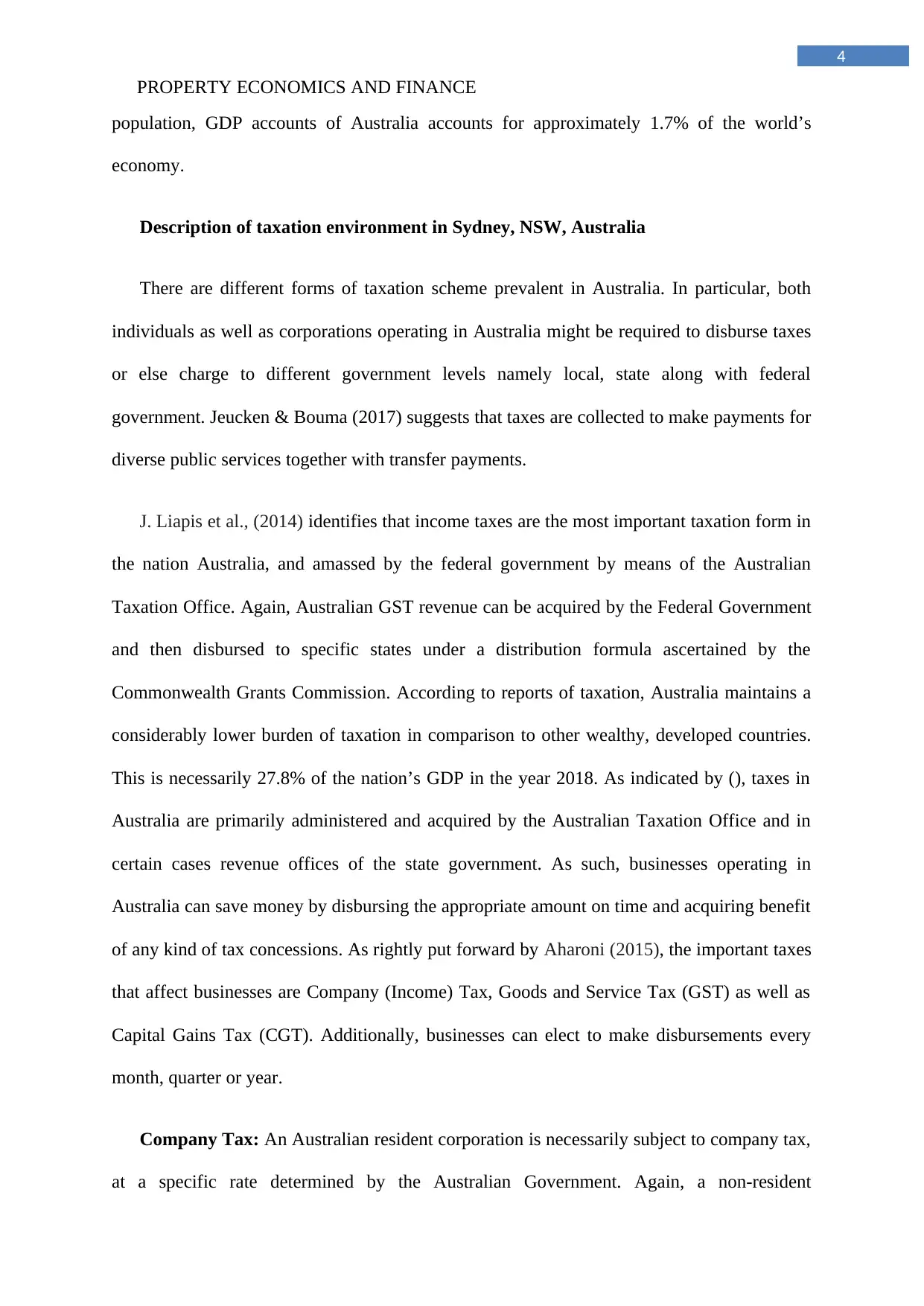
4
PROPERTY ECONOMICS AND FINANCE
population, GDP accounts of Australia accounts for approximately 1.7% of the world’s
economy.
Description of taxation environment in Sydney, NSW, Australia
There are different forms of taxation scheme prevalent in Australia. In particular, both
individuals as well as corporations operating in Australia might be required to disburse taxes
or else charge to different government levels namely local, state along with federal
government. Jeucken & Bouma (2017) suggests that taxes are collected to make payments for
diverse public services together with transfer payments.
J. Liapis et al., (2014) identifies that income taxes are the most important taxation form in
the nation Australia, and amassed by the federal government by means of the Australian
Taxation Office. Again, Australian GST revenue can be acquired by the Federal Government
and then disbursed to specific states under a distribution formula ascertained by the
Commonwealth Grants Commission. According to reports of taxation, Australia maintains a
considerably lower burden of taxation in comparison to other wealthy, developed countries.
This is necessarily 27.8% of the nation’s GDP in the year 2018. As indicated by (), taxes in
Australia are primarily administered and acquired by the Australian Taxation Office and in
certain cases revenue offices of the state government. As such, businesses operating in
Australia can save money by disbursing the appropriate amount on time and acquiring benefit
of any kind of tax concessions. As rightly put forward by Aharoni (2015), the important taxes
that affect businesses are Company (Income) Tax, Goods and Service Tax (GST) as well as
Capital Gains Tax (CGT). Additionally, businesses can elect to make disbursements every
month, quarter or year.
Company Tax: An Australian resident corporation is necessarily subject to company tax,
at a specific rate determined by the Australian Government. Again, a non-resident
PROPERTY ECONOMICS AND FINANCE
population, GDP accounts of Australia accounts for approximately 1.7% of the world’s
economy.
Description of taxation environment in Sydney, NSW, Australia
There are different forms of taxation scheme prevalent in Australia. In particular, both
individuals as well as corporations operating in Australia might be required to disburse taxes
or else charge to different government levels namely local, state along with federal
government. Jeucken & Bouma (2017) suggests that taxes are collected to make payments for
diverse public services together with transfer payments.
J. Liapis et al., (2014) identifies that income taxes are the most important taxation form in
the nation Australia, and amassed by the federal government by means of the Australian
Taxation Office. Again, Australian GST revenue can be acquired by the Federal Government
and then disbursed to specific states under a distribution formula ascertained by the
Commonwealth Grants Commission. According to reports of taxation, Australia maintains a
considerably lower burden of taxation in comparison to other wealthy, developed countries.
This is necessarily 27.8% of the nation’s GDP in the year 2018. As indicated by (), taxes in
Australia are primarily administered and acquired by the Australian Taxation Office and in
certain cases revenue offices of the state government. As such, businesses operating in
Australia can save money by disbursing the appropriate amount on time and acquiring benefit
of any kind of tax concessions. As rightly put forward by Aharoni (2015), the important taxes
that affect businesses are Company (Income) Tax, Goods and Service Tax (GST) as well as
Capital Gains Tax (CGT). Additionally, businesses can elect to make disbursements every
month, quarter or year.
Company Tax: An Australian resident corporation is necessarily subject to company tax,
at a specific rate determined by the Australian Government. Again, a non-resident
Paraphrase This Document
Need a fresh take? Get an instant paraphrase of this document with our AI Paraphraser
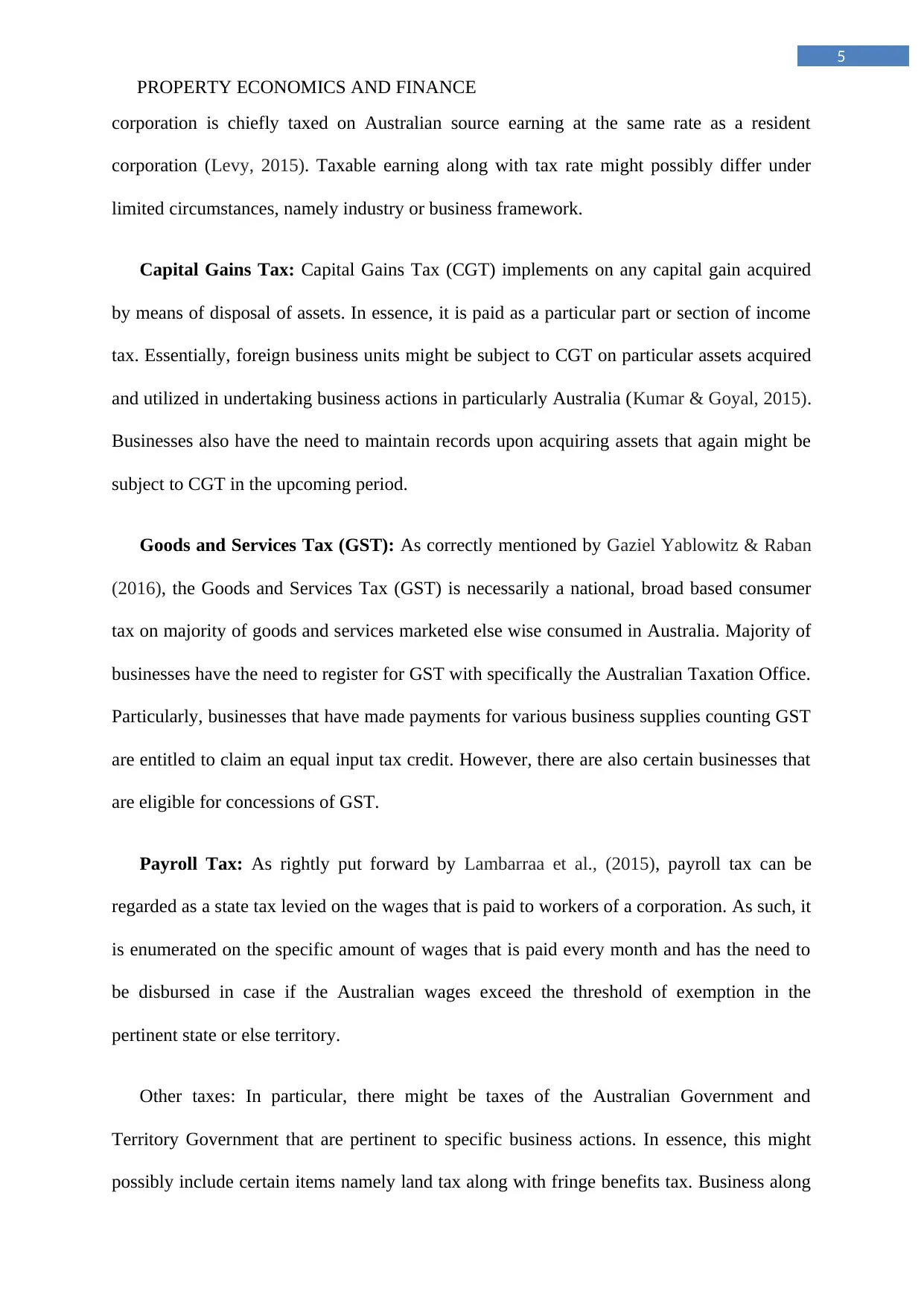
5
PROPERTY ECONOMICS AND FINANCE
corporation is chiefly taxed on Australian source earning at the same rate as a resident
corporation (Levy, 2015). Taxable earning along with tax rate might possibly differ under
limited circumstances, namely industry or business framework.
Capital Gains Tax: Capital Gains Tax (CGT) implements on any capital gain acquired
by means of disposal of assets. In essence, it is paid as a particular part or section of income
tax. Essentially, foreign business units might be subject to CGT on particular assets acquired
and utilized in undertaking business actions in particularly Australia (Kumar & Goyal, 2015).
Businesses also have the need to maintain records upon acquiring assets that again might be
subject to CGT in the upcoming period.
Goods and Services Tax (GST): As correctly mentioned by Gaziel Yablowitz & Raban
(2016), the Goods and Services Tax (GST) is necessarily a national, broad based consumer
tax on majority of goods and services marketed else wise consumed in Australia. Majority of
businesses have the need to register for GST with specifically the Australian Taxation Office.
Particularly, businesses that have made payments for various business supplies counting GST
are entitled to claim an equal input tax credit. However, there are also certain businesses that
are eligible for concessions of GST.
Payroll Tax: As rightly put forward by Lambarraa et al., (2015), payroll tax can be
regarded as a state tax levied on the wages that is paid to workers of a corporation. As such, it
is enumerated on the specific amount of wages that is paid every month and has the need to
be disbursed in case if the Australian wages exceed the threshold of exemption in the
pertinent state or else territory.
Other taxes: In particular, there might be taxes of the Australian Government and
Territory Government that are pertinent to specific business actions. In essence, this might
possibly include certain items namely land tax along with fringe benefits tax. Business along
PROPERTY ECONOMICS AND FINANCE
corporation is chiefly taxed on Australian source earning at the same rate as a resident
corporation (Levy, 2015). Taxable earning along with tax rate might possibly differ under
limited circumstances, namely industry or business framework.
Capital Gains Tax: Capital Gains Tax (CGT) implements on any capital gain acquired
by means of disposal of assets. In essence, it is paid as a particular part or section of income
tax. Essentially, foreign business units might be subject to CGT on particular assets acquired
and utilized in undertaking business actions in particularly Australia (Kumar & Goyal, 2015).
Businesses also have the need to maintain records upon acquiring assets that again might be
subject to CGT in the upcoming period.
Goods and Services Tax (GST): As correctly mentioned by Gaziel Yablowitz & Raban
(2016), the Goods and Services Tax (GST) is necessarily a national, broad based consumer
tax on majority of goods and services marketed else wise consumed in Australia. Majority of
businesses have the need to register for GST with specifically the Australian Taxation Office.
Particularly, businesses that have made payments for various business supplies counting GST
are entitled to claim an equal input tax credit. However, there are also certain businesses that
are eligible for concessions of GST.
Payroll Tax: As rightly put forward by Lambarraa et al., (2015), payroll tax can be
regarded as a state tax levied on the wages that is paid to workers of a corporation. As such, it
is enumerated on the specific amount of wages that is paid every month and has the need to
be disbursed in case if the Australian wages exceed the threshold of exemption in the
pertinent state or else territory.
Other taxes: In particular, there might be taxes of the Australian Government and
Territory Government that are pertinent to specific business actions. In essence, this might
possibly include certain items namely land tax along with fringe benefits tax. Business along
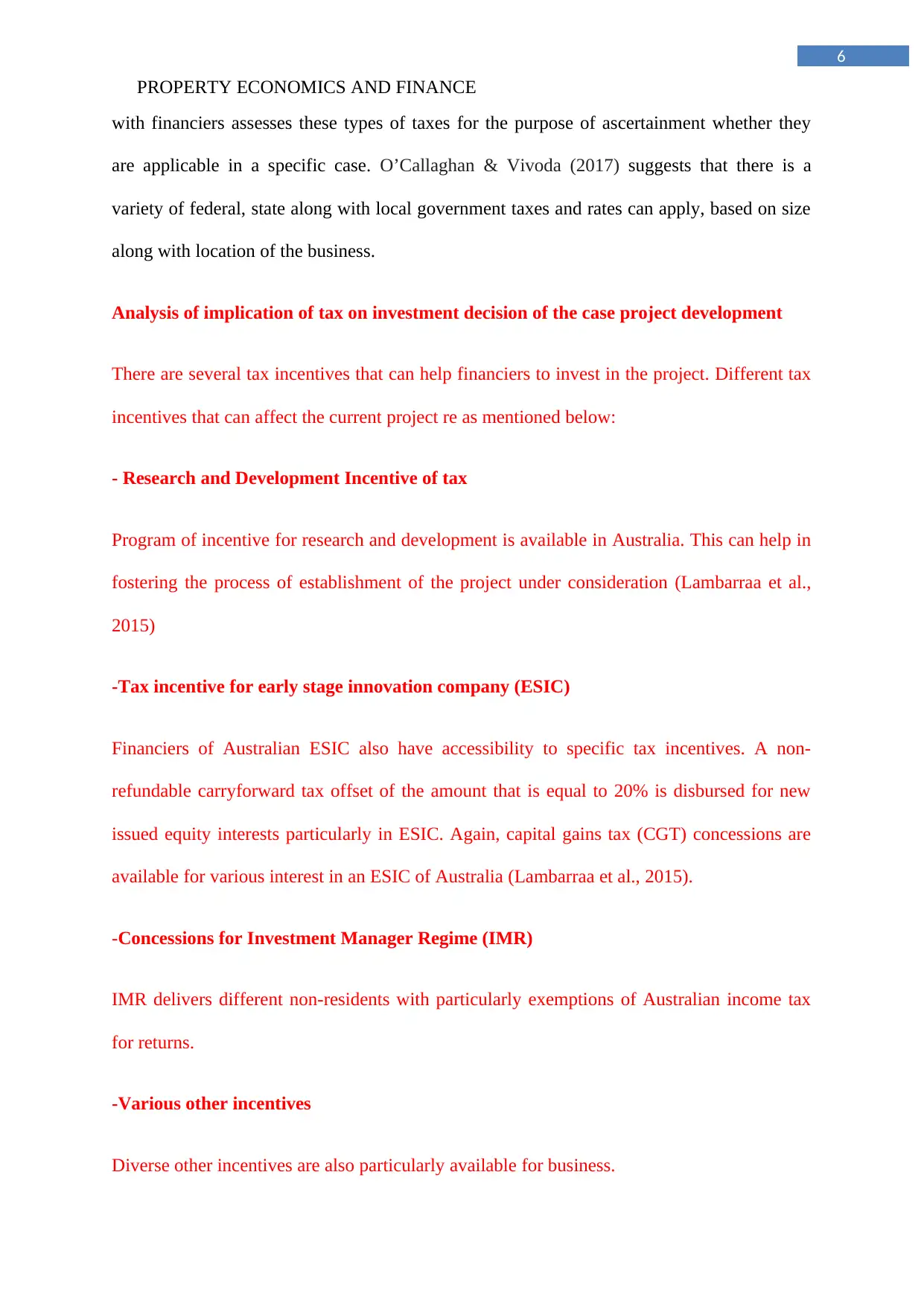
6
PROPERTY ECONOMICS AND FINANCE
with financiers assesses these types of taxes for the purpose of ascertainment whether they
are applicable in a specific case. O’Callaghan & Vivoda (2017) suggests that there is a
variety of federal, state along with local government taxes and rates can apply, based on size
along with location of the business.
Analysis of implication of tax on investment decision of the case project development
There are several tax incentives that can help financiers to invest in the project. Different tax
incentives that can affect the current project re as mentioned below:
- Research and Development Incentive of tax
Program of incentive for research and development is available in Australia. This can help in
fostering the process of establishment of the project under consideration (Lambarraa et al.,
2015)
-Tax incentive for early stage innovation company (ESIC)
Financiers of Australian ESIC also have accessibility to specific tax incentives. A non-
refundable carryforward tax offset of the amount that is equal to 20% is disbursed for new
issued equity interests particularly in ESIC. Again, capital gains tax (CGT) concessions are
available for various interest in an ESIC of Australia (Lambarraa et al., 2015).
-Concessions for Investment Manager Regime (IMR)
IMR delivers different non-residents with particularly exemptions of Australian income tax
for returns.
-Various other incentives
Diverse other incentives are also particularly available for business.
PROPERTY ECONOMICS AND FINANCE
with financiers assesses these types of taxes for the purpose of ascertainment whether they
are applicable in a specific case. O’Callaghan & Vivoda (2017) suggests that there is a
variety of federal, state along with local government taxes and rates can apply, based on size
along with location of the business.
Analysis of implication of tax on investment decision of the case project development
There are several tax incentives that can help financiers to invest in the project. Different tax
incentives that can affect the current project re as mentioned below:
- Research and Development Incentive of tax
Program of incentive for research and development is available in Australia. This can help in
fostering the process of establishment of the project under consideration (Lambarraa et al.,
2015)
-Tax incentive for early stage innovation company (ESIC)
Financiers of Australian ESIC also have accessibility to specific tax incentives. A non-
refundable carryforward tax offset of the amount that is equal to 20% is disbursed for new
issued equity interests particularly in ESIC. Again, capital gains tax (CGT) concessions are
available for various interest in an ESIC of Australia (Lambarraa et al., 2015).
-Concessions for Investment Manager Regime (IMR)
IMR delivers different non-residents with particularly exemptions of Australian income tax
for returns.
-Various other incentives
Diverse other incentives are also particularly available for business.
⊘ This is a preview!⊘
Do you want full access?
Subscribe today to unlock all pages.

Trusted by 1+ million students worldwide
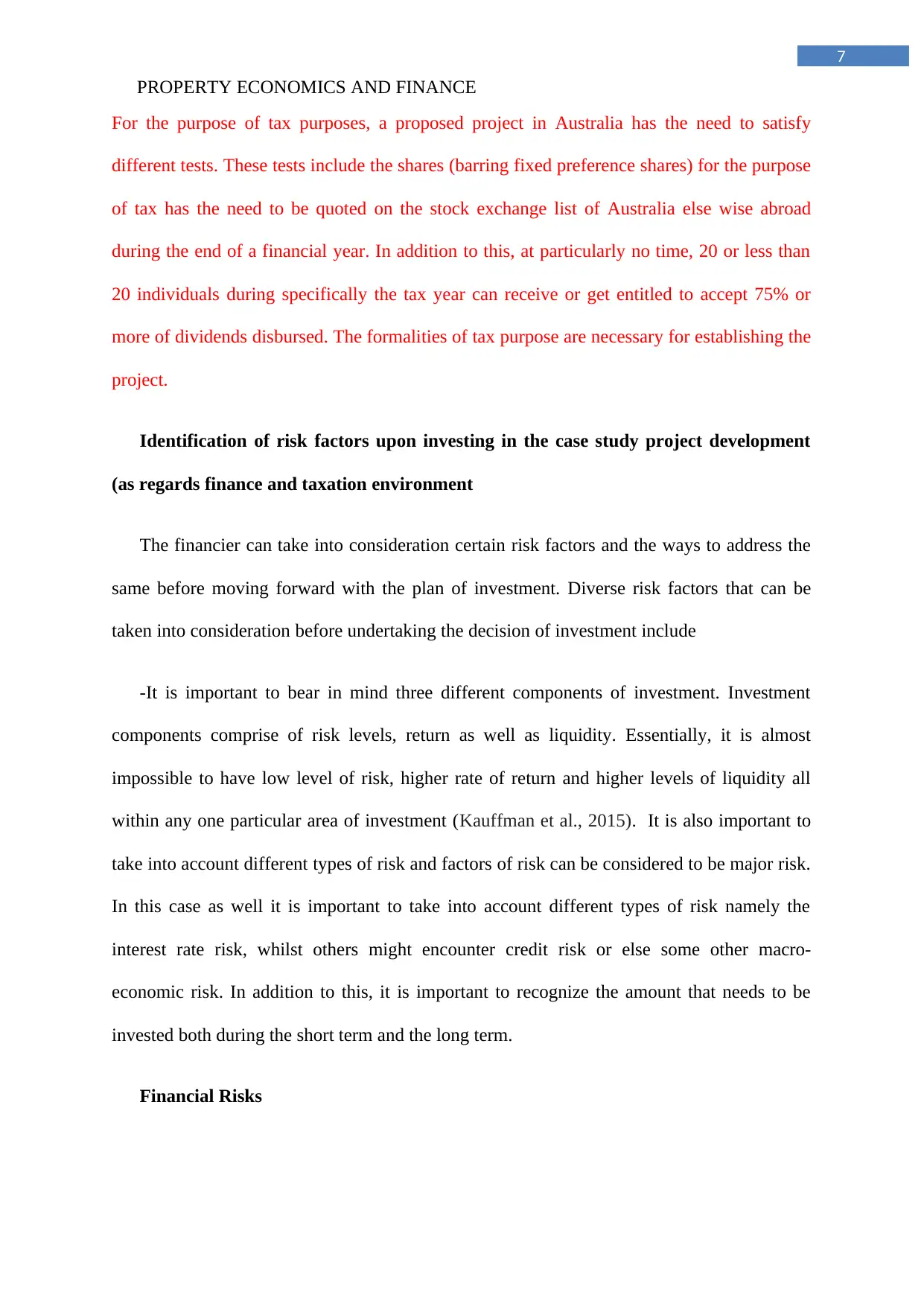
7
PROPERTY ECONOMICS AND FINANCE
For the purpose of tax purposes, a proposed project in Australia has the need to satisfy
different tests. These tests include the shares (barring fixed preference shares) for the purpose
of tax has the need to be quoted on the stock exchange list of Australia else wise abroad
during the end of a financial year. In addition to this, at particularly no time, 20 or less than
20 individuals during specifically the tax year can receive or get entitled to accept 75% or
more of dividends disbursed. The formalities of tax purpose are necessary for establishing the
project.
Identification of risk factors upon investing in the case study project development
(as regards finance and taxation environment
The financier can take into consideration certain risk factors and the ways to address the
same before moving forward with the plan of investment. Diverse risk factors that can be
taken into consideration before undertaking the decision of investment include
-It is important to bear in mind three different components of investment. Investment
components comprise of risk levels, return as well as liquidity. Essentially, it is almost
impossible to have low level of risk, higher rate of return and higher levels of liquidity all
within any one particular area of investment (Kauffman et al., 2015). It is also important to
take into account different types of risk and factors of risk can be considered to be major risk.
In this case as well it is important to take into account different types of risk namely the
interest rate risk, whilst others might encounter credit risk or else some other macro-
economic risk. In addition to this, it is important to recognize the amount that needs to be
invested both during the short term and the long term.
Financial Risks
PROPERTY ECONOMICS AND FINANCE
For the purpose of tax purposes, a proposed project in Australia has the need to satisfy
different tests. These tests include the shares (barring fixed preference shares) for the purpose
of tax has the need to be quoted on the stock exchange list of Australia else wise abroad
during the end of a financial year. In addition to this, at particularly no time, 20 or less than
20 individuals during specifically the tax year can receive or get entitled to accept 75% or
more of dividends disbursed. The formalities of tax purpose are necessary for establishing the
project.
Identification of risk factors upon investing in the case study project development
(as regards finance and taxation environment
The financier can take into consideration certain risk factors and the ways to address the
same before moving forward with the plan of investment. Diverse risk factors that can be
taken into consideration before undertaking the decision of investment include
-It is important to bear in mind three different components of investment. Investment
components comprise of risk levels, return as well as liquidity. Essentially, it is almost
impossible to have low level of risk, higher rate of return and higher levels of liquidity all
within any one particular area of investment (Kauffman et al., 2015). It is also important to
take into account different types of risk and factors of risk can be considered to be major risk.
In this case as well it is important to take into account different types of risk namely the
interest rate risk, whilst others might encounter credit risk or else some other macro-
economic risk. In addition to this, it is important to recognize the amount that needs to be
invested both during the short term and the long term.
Financial Risks
Paraphrase This Document
Need a fresh take? Get an instant paraphrase of this document with our AI Paraphraser
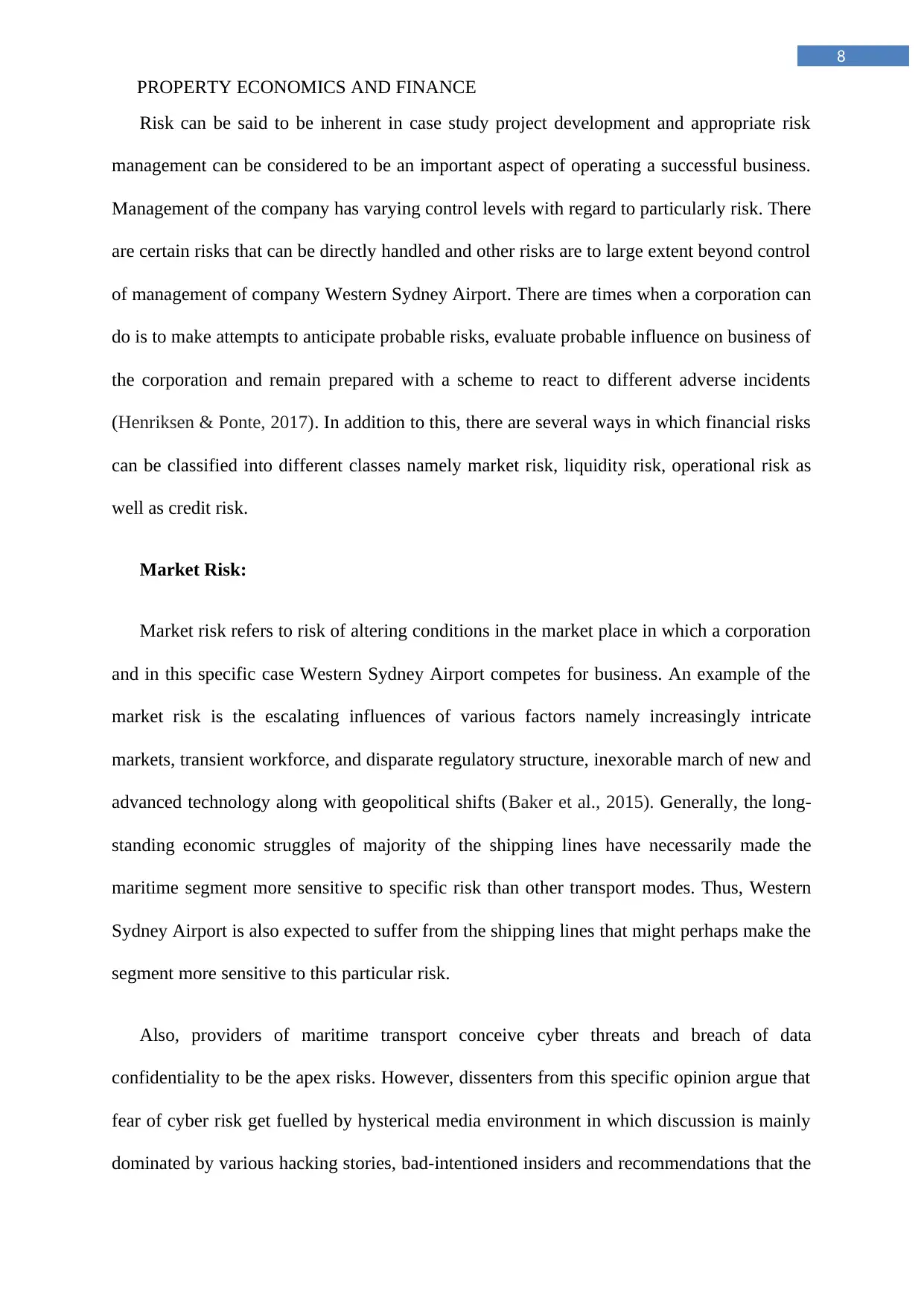
8
PROPERTY ECONOMICS AND FINANCE
Risk can be said to be inherent in case study project development and appropriate risk
management can be considered to be an important aspect of operating a successful business.
Management of the company has varying control levels with regard to particularly risk. There
are certain risks that can be directly handled and other risks are to large extent beyond control
of management of company Western Sydney Airport. There are times when a corporation can
do is to make attempts to anticipate probable risks, evaluate probable influence on business of
the corporation and remain prepared with a scheme to react to different adverse incidents
(Henriksen & Ponte, 2017). In addition to this, there are several ways in which financial risks
can be classified into different classes namely market risk, liquidity risk, operational risk as
well as credit risk.
Market Risk:
Market risk refers to risk of altering conditions in the market place in which a corporation
and in this specific case Western Sydney Airport competes for business. An example of the
market risk is the escalating influences of various factors namely increasingly intricate
markets, transient workforce, and disparate regulatory structure, inexorable march of new and
advanced technology along with geopolitical shifts (Baker et al., 2015). Generally, the long-
standing economic struggles of majority of the shipping lines have necessarily made the
maritime segment more sensitive to specific risk than other transport modes. Thus, Western
Sydney Airport is also expected to suffer from the shipping lines that might perhaps make the
segment more sensitive to this particular risk.
Also, providers of maritime transport conceive cyber threats and breach of data
confidentiality to be the apex risks. However, dissenters from this specific opinion argue that
fear of cyber risk get fuelled by hysterical media environment in which discussion is mainly
dominated by various hacking stories, bad-intentioned insiders and recommendations that the
PROPERTY ECONOMICS AND FINANCE
Risk can be said to be inherent in case study project development and appropriate risk
management can be considered to be an important aspect of operating a successful business.
Management of the company has varying control levels with regard to particularly risk. There
are certain risks that can be directly handled and other risks are to large extent beyond control
of management of company Western Sydney Airport. There are times when a corporation can
do is to make attempts to anticipate probable risks, evaluate probable influence on business of
the corporation and remain prepared with a scheme to react to different adverse incidents
(Henriksen & Ponte, 2017). In addition to this, there are several ways in which financial risks
can be classified into different classes namely market risk, liquidity risk, operational risk as
well as credit risk.
Market Risk:
Market risk refers to risk of altering conditions in the market place in which a corporation
and in this specific case Western Sydney Airport competes for business. An example of the
market risk is the escalating influences of various factors namely increasingly intricate
markets, transient workforce, and disparate regulatory structure, inexorable march of new and
advanced technology along with geopolitical shifts (Baker et al., 2015). Generally, the long-
standing economic struggles of majority of the shipping lines have necessarily made the
maritime segment more sensitive to specific risk than other transport modes. Thus, Western
Sydney Airport is also expected to suffer from the shipping lines that might perhaps make the
segment more sensitive to this particular risk.
Also, providers of maritime transport conceive cyber threats and breach of data
confidentiality to be the apex risks. However, dissenters from this specific opinion argue that
fear of cyber risk get fuelled by hysterical media environment in which discussion is mainly
dominated by various hacking stories, bad-intentioned insiders and recommendations that the
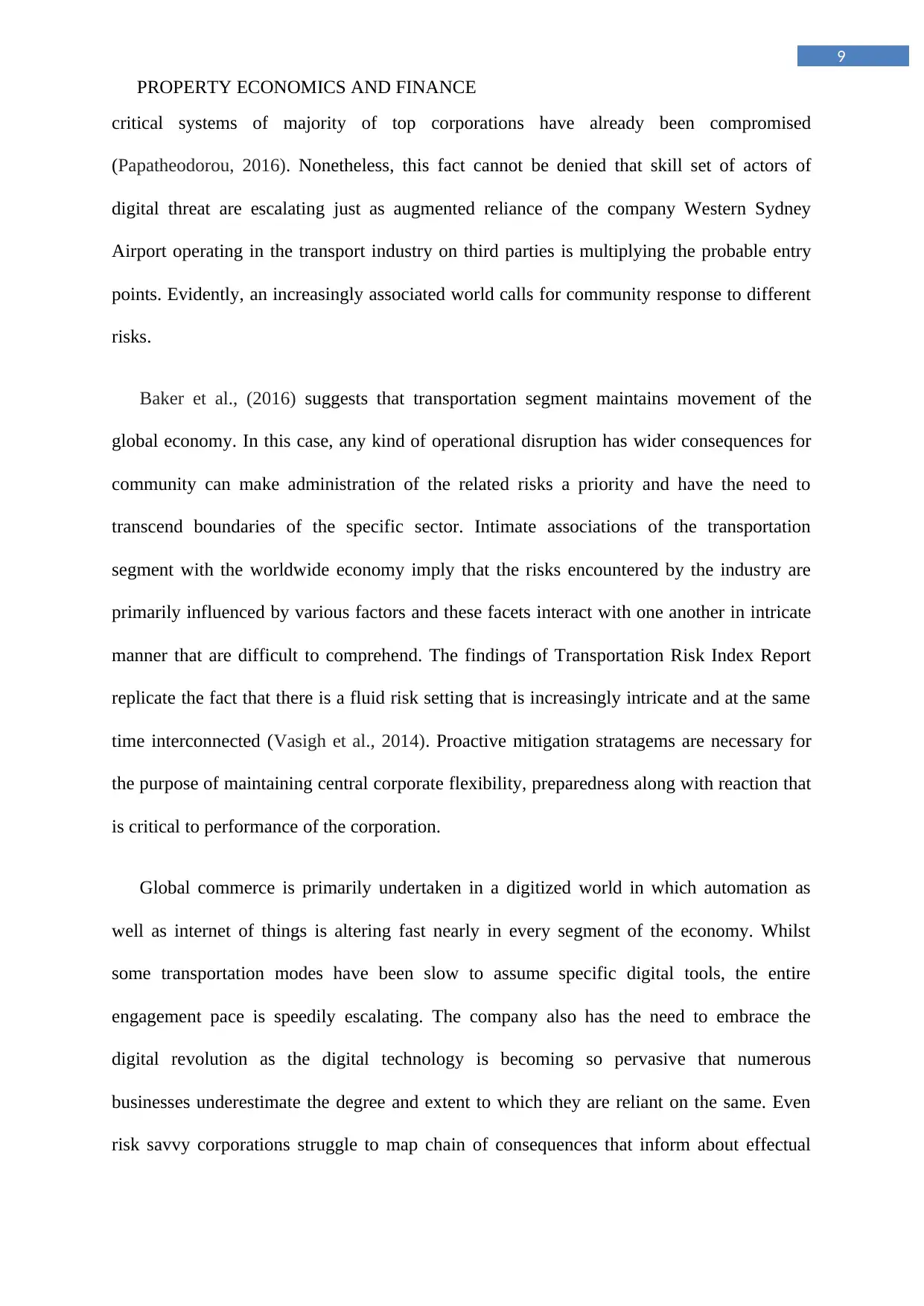
9
PROPERTY ECONOMICS AND FINANCE
critical systems of majority of top corporations have already been compromised
(Papatheodorou, 2016). Nonetheless, this fact cannot be denied that skill set of actors of
digital threat are escalating just as augmented reliance of the company Western Sydney
Airport operating in the transport industry on third parties is multiplying the probable entry
points. Evidently, an increasingly associated world calls for community response to different
risks.
Baker et al., (2016) suggests that transportation segment maintains movement of the
global economy. In this case, any kind of operational disruption has wider consequences for
community can make administration of the related risks a priority and have the need to
transcend boundaries of the specific sector. Intimate associations of the transportation
segment with the worldwide economy imply that the risks encountered by the industry are
primarily influenced by various factors and these facets interact with one another in intricate
manner that are difficult to comprehend. The findings of Transportation Risk Index Report
replicate the fact that there is a fluid risk setting that is increasingly intricate and at the same
time interconnected (Vasigh et al., 2014). Proactive mitigation stratagems are necessary for
the purpose of maintaining central corporate flexibility, preparedness along with reaction that
is critical to performance of the corporation.
Global commerce is primarily undertaken in a digitized world in which automation as
well as internet of things is altering fast nearly in every segment of the economy. Whilst
some transportation modes have been slow to assume specific digital tools, the entire
engagement pace is speedily escalating. The company also has the need to embrace the
digital revolution as the digital technology is becoming so pervasive that numerous
businesses underestimate the degree and extent to which they are reliant on the same. Even
risk savvy corporations struggle to map chain of consequences that inform about effectual
PROPERTY ECONOMICS AND FINANCE
critical systems of majority of top corporations have already been compromised
(Papatheodorou, 2016). Nonetheless, this fact cannot be denied that skill set of actors of
digital threat are escalating just as augmented reliance of the company Western Sydney
Airport operating in the transport industry on third parties is multiplying the probable entry
points. Evidently, an increasingly associated world calls for community response to different
risks.
Baker et al., (2016) suggests that transportation segment maintains movement of the
global economy. In this case, any kind of operational disruption has wider consequences for
community can make administration of the related risks a priority and have the need to
transcend boundaries of the specific sector. Intimate associations of the transportation
segment with the worldwide economy imply that the risks encountered by the industry are
primarily influenced by various factors and these facets interact with one another in intricate
manner that are difficult to comprehend. The findings of Transportation Risk Index Report
replicate the fact that there is a fluid risk setting that is increasingly intricate and at the same
time interconnected (Vasigh et al., 2014). Proactive mitigation stratagems are necessary for
the purpose of maintaining central corporate flexibility, preparedness along with reaction that
is critical to performance of the corporation.
Global commerce is primarily undertaken in a digitized world in which automation as
well as internet of things is altering fast nearly in every segment of the economy. Whilst
some transportation modes have been slow to assume specific digital tools, the entire
engagement pace is speedily escalating. The company also has the need to embrace the
digital revolution as the digital technology is becoming so pervasive that numerous
businesses underestimate the degree and extent to which they are reliant on the same. Even
risk savvy corporations struggle to map chain of consequences that inform about effectual
⊘ This is a preview!⊘
Do you want full access?
Subscribe today to unlock all pages.

Trusted by 1+ million students worldwide
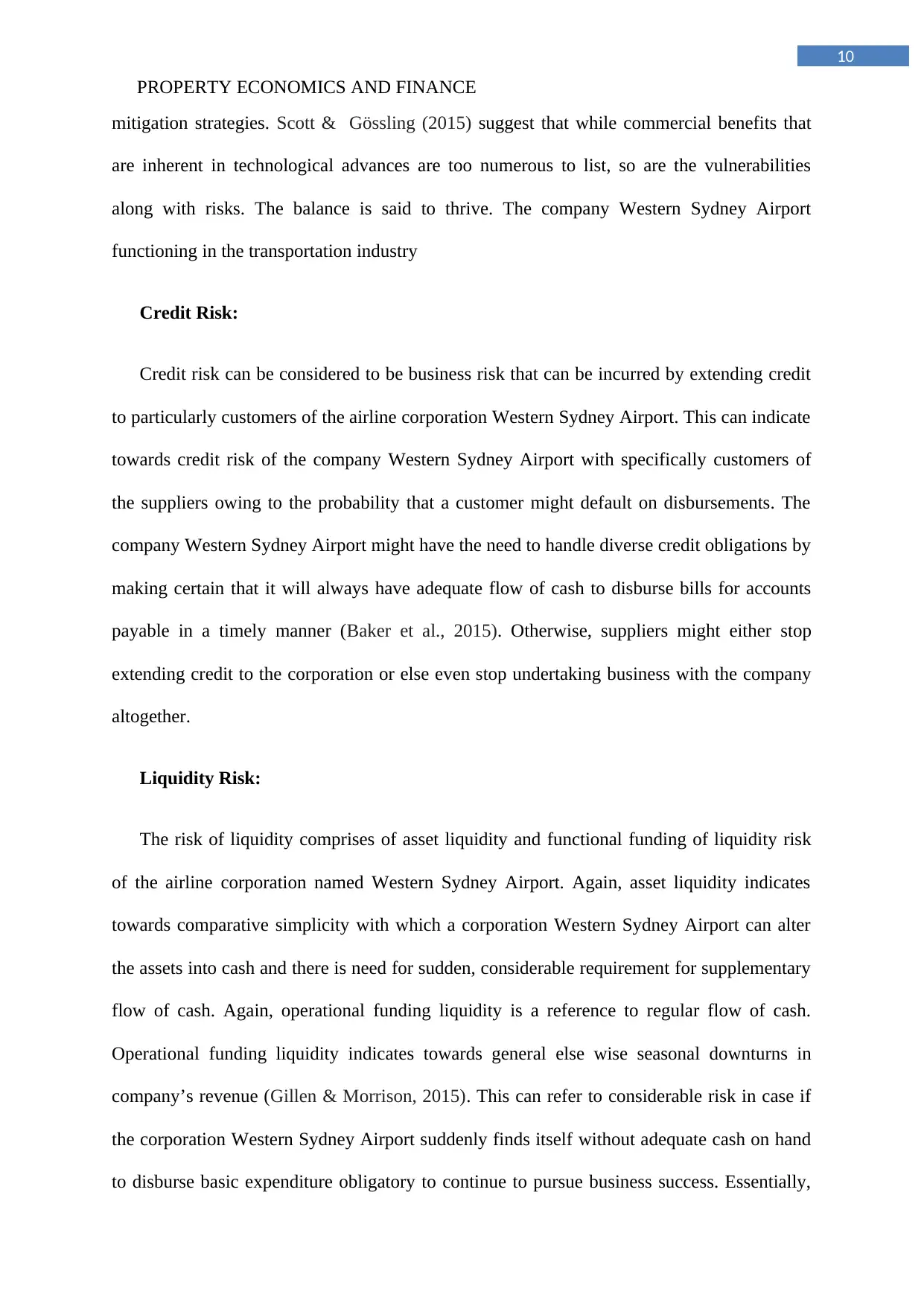
10
PROPERTY ECONOMICS AND FINANCE
mitigation strategies. Scott & Gössling (2015) suggest that while commercial benefits that
are inherent in technological advances are too numerous to list, so are the vulnerabilities
along with risks. The balance is said to thrive. The company Western Sydney Airport
functioning in the transportation industry
Credit Risk:
Credit risk can be considered to be business risk that can be incurred by extending credit
to particularly customers of the airline corporation Western Sydney Airport. This can indicate
towards credit risk of the company Western Sydney Airport with specifically customers of
the suppliers owing to the probability that a customer might default on disbursements. The
company Western Sydney Airport might have the need to handle diverse credit obligations by
making certain that it will always have adequate flow of cash to disburse bills for accounts
payable in a timely manner (Baker et al., 2015). Otherwise, suppliers might either stop
extending credit to the corporation or else even stop undertaking business with the company
altogether.
Liquidity Risk:
The risk of liquidity comprises of asset liquidity and functional funding of liquidity risk
of the airline corporation named Western Sydney Airport. Again, asset liquidity indicates
towards comparative simplicity with which a corporation Western Sydney Airport can alter
the assets into cash and there is need for sudden, considerable requirement for supplementary
flow of cash. Again, operational funding liquidity is a reference to regular flow of cash.
Operational funding liquidity indicates towards general else wise seasonal downturns in
company’s revenue (Gillen & Morrison, 2015). This can refer to considerable risk in case if
the corporation Western Sydney Airport suddenly finds itself without adequate cash on hand
to disburse basic expenditure obligatory to continue to pursue business success. Essentially,
PROPERTY ECONOMICS AND FINANCE
mitigation strategies. Scott & Gössling (2015) suggest that while commercial benefits that
are inherent in technological advances are too numerous to list, so are the vulnerabilities
along with risks. The balance is said to thrive. The company Western Sydney Airport
functioning in the transportation industry
Credit Risk:
Credit risk can be considered to be business risk that can be incurred by extending credit
to particularly customers of the airline corporation Western Sydney Airport. This can indicate
towards credit risk of the company Western Sydney Airport with specifically customers of
the suppliers owing to the probability that a customer might default on disbursements. The
company Western Sydney Airport might have the need to handle diverse credit obligations by
making certain that it will always have adequate flow of cash to disburse bills for accounts
payable in a timely manner (Baker et al., 2015). Otherwise, suppliers might either stop
extending credit to the corporation or else even stop undertaking business with the company
altogether.
Liquidity Risk:
The risk of liquidity comprises of asset liquidity and functional funding of liquidity risk
of the airline corporation named Western Sydney Airport. Again, asset liquidity indicates
towards comparative simplicity with which a corporation Western Sydney Airport can alter
the assets into cash and there is need for sudden, considerable requirement for supplementary
flow of cash. Again, operational funding liquidity is a reference to regular flow of cash.
Operational funding liquidity indicates towards general else wise seasonal downturns in
company’s revenue (Gillen & Morrison, 2015). This can refer to considerable risk in case if
the corporation Western Sydney Airport suddenly finds itself without adequate cash on hand
to disburse basic expenditure obligatory to continue to pursue business success. Essentially,
Paraphrase This Document
Need a fresh take? Get an instant paraphrase of this document with our AI Paraphraser

11
PROPERTY ECONOMICS AND FINANCE
this is the reason behind management of flow of cash can be considered to be critical to
success of the business and financiers view at dimensions namely free flow of cash at the
time of evaluating firms as an equity investment (Abbott, 2018).
PROPERTY ECONOMICS AND FINANCE
this is the reason behind management of flow of cash can be considered to be critical to
success of the business and financiers view at dimensions namely free flow of cash at the
time of evaluating firms as an equity investment (Abbott, 2018).
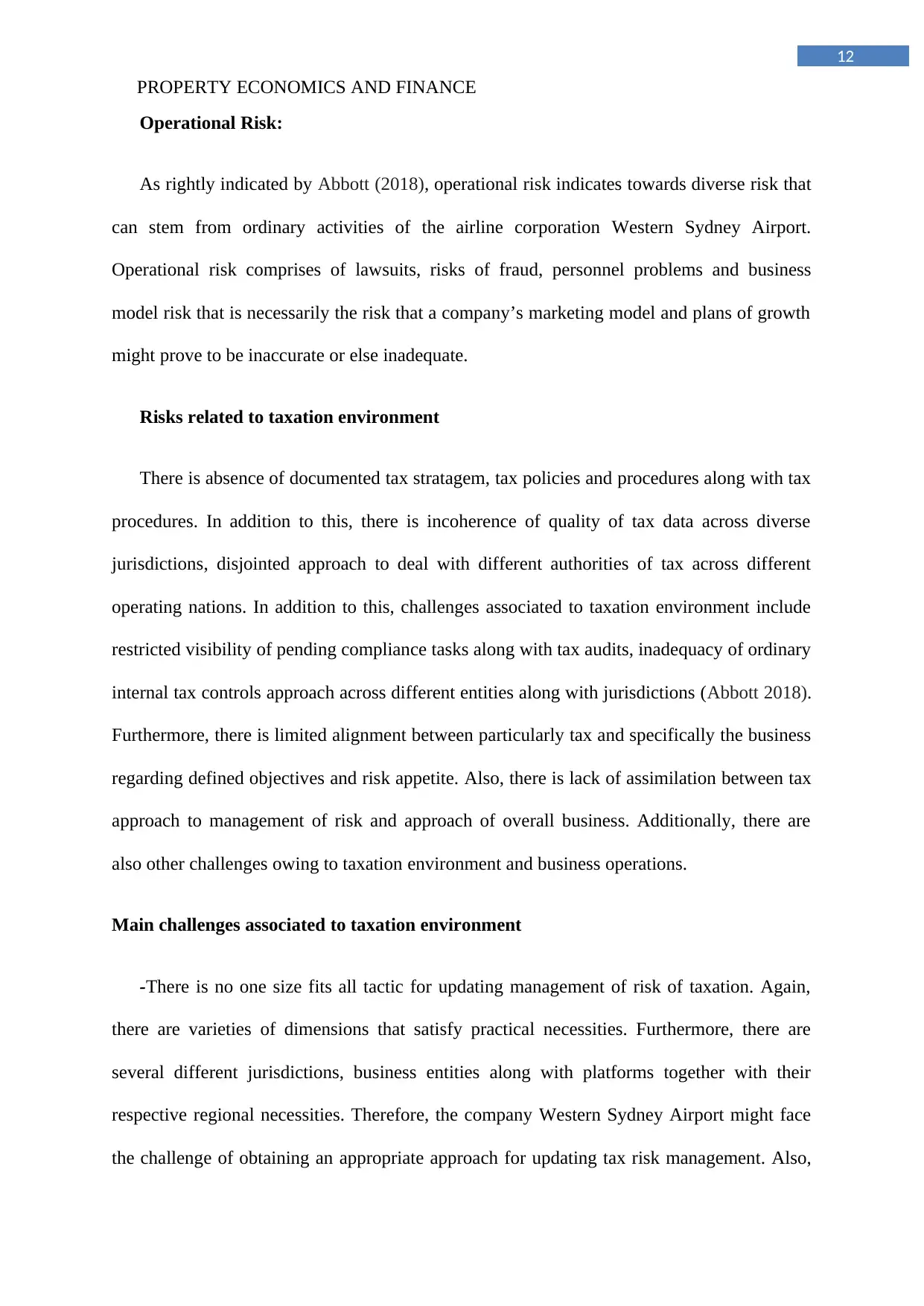
12
PROPERTY ECONOMICS AND FINANCE
Operational Risk:
As rightly indicated by Abbott (2018), operational risk indicates towards diverse risk that
can stem from ordinary activities of the airline corporation Western Sydney Airport.
Operational risk comprises of lawsuits, risks of fraud, personnel problems and business
model risk that is necessarily the risk that a company’s marketing model and plans of growth
might prove to be inaccurate or else inadequate.
Risks related to taxation environment
There is absence of documented tax stratagem, tax policies and procedures along with tax
procedures. In addition to this, there is incoherence of quality of tax data across diverse
jurisdictions, disjointed approach to deal with different authorities of tax across different
operating nations. In addition to this, challenges associated to taxation environment include
restricted visibility of pending compliance tasks along with tax audits, inadequacy of ordinary
internal tax controls approach across different entities along with jurisdictions (Abbott 2018).
Furthermore, there is limited alignment between particularly tax and specifically the business
regarding defined objectives and risk appetite. Also, there is lack of assimilation between tax
approach to management of risk and approach of overall business. Additionally, there are
also other challenges owing to taxation environment and business operations.
Main challenges associated to taxation environment
-There is no one size fits all tactic for updating management of risk of taxation. Again,
there are varieties of dimensions that satisfy practical necessities. Furthermore, there are
several different jurisdictions, business entities along with platforms together with their
respective regional necessities. Therefore, the company Western Sydney Airport might face
the challenge of obtaining an appropriate approach for updating tax risk management. Also,
PROPERTY ECONOMICS AND FINANCE
Operational Risk:
As rightly indicated by Abbott (2018), operational risk indicates towards diverse risk that
can stem from ordinary activities of the airline corporation Western Sydney Airport.
Operational risk comprises of lawsuits, risks of fraud, personnel problems and business
model risk that is necessarily the risk that a company’s marketing model and plans of growth
might prove to be inaccurate or else inadequate.
Risks related to taxation environment
There is absence of documented tax stratagem, tax policies and procedures along with tax
procedures. In addition to this, there is incoherence of quality of tax data across diverse
jurisdictions, disjointed approach to deal with different authorities of tax across different
operating nations. In addition to this, challenges associated to taxation environment include
restricted visibility of pending compliance tasks along with tax audits, inadequacy of ordinary
internal tax controls approach across different entities along with jurisdictions (Abbott 2018).
Furthermore, there is limited alignment between particularly tax and specifically the business
regarding defined objectives and risk appetite. Also, there is lack of assimilation between tax
approach to management of risk and approach of overall business. Additionally, there are
also other challenges owing to taxation environment and business operations.
Main challenges associated to taxation environment
-There is no one size fits all tactic for updating management of risk of taxation. Again,
there are varieties of dimensions that satisfy practical necessities. Furthermore, there are
several different jurisdictions, business entities along with platforms together with their
respective regional necessities. Therefore, the company Western Sydney Airport might face
the challenge of obtaining an appropriate approach for updating tax risk management. Also,
⊘ This is a preview!⊘
Do you want full access?
Subscribe today to unlock all pages.

Trusted by 1+ million students worldwide
1 out of 26
Related Documents
Your All-in-One AI-Powered Toolkit for Academic Success.
+13062052269
info@desklib.com
Available 24*7 on WhatsApp / Email
![[object Object]](/_next/static/media/star-bottom.7253800d.svg)
Unlock your academic potential
Copyright © 2020–2025 A2Z Services. All Rights Reserved. Developed and managed by ZUCOL.




